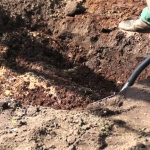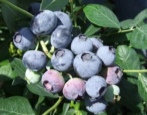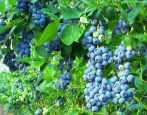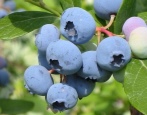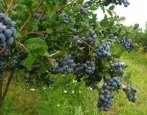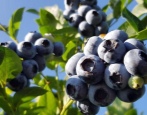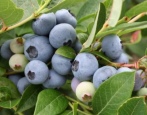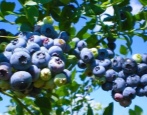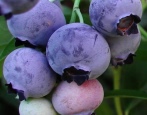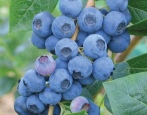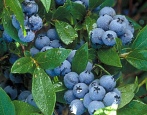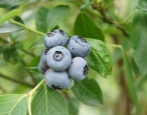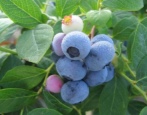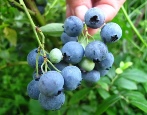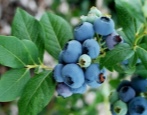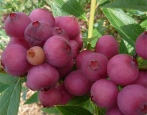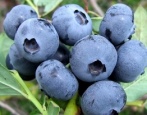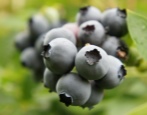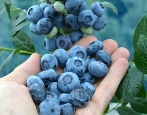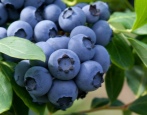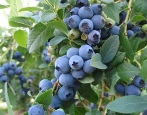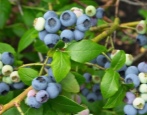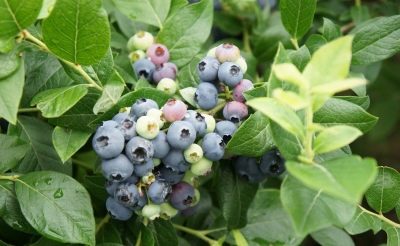
- Ripening terms: mid-early
- Growth type: undersized
- Bush height, m: 0,6–1,2
- Taste: pleasant, sweet and sour
- Yield: small
- Average yield: 2.5 kg per bush
- Fruit size: large
- Fruit color: dark blue
- Description of the bush: powerful
- Transportability: good
Northblue blueberries were included in the symbolic top 20 of the best varieties. And this is quite explainable by its many advantages. Therefore, in order to successfully grow a crop, it is worth studying its features, as well as providing proper care.
Breeding history
Northblue blueberry culture, like many others, was developed in the USA on the basis of the 1973 breeding program. A group of American specialists used seedlings of tall blueberries and low-growing narrow-leaved Canadian species - US-3, G-65, Asworth as a basis. The resulting hybrid is characterized by record frost resistance.
Description of the variety
Blueberries of the considered variety are low-growing bushes with a height of 60 to 80 centimeters, in rare cases they grow up to 1.2 meters.
The root system is superficial and branched. The growth rate is average, 5 shoots appear in one year.
The crown of the plant is quite spreading. The 5-centimeter leaves are ovoid in shape, with pointed ends. The leaf plates have a dark green upper color, they are matte at the bottom.
The shrub blooms at the end of May with bell-shaped flowers with cream petals, collected in paniculate inflorescences, each inflorescence with 6-10 flowers.
Fruit characteristics
Blueberries of the American variety are large, their weight is 2.5-3 grams, the average diameter is from 15 to 18 mm. As already noted, they are formed in the brushes. The skin color is dark blue, there is a bluish bloom. Blueberries can be stored for up to 10 days in a regular refrigerator. But if you define the product in conditions with zero temperature, the shelf life can be extended by 3-4 weeks.
Taste qualities
The pulp of blueberries is quite dense, sweet, but there is a little bit of sourness. The tasters rated the fruits of the Northblue variety quite high on a 5-point scale - up to 4.9 points.
In order to be able to use this useful product for consumption in winter, the berries are frozen. But more often they eat them fresh, make preparations: compote, jam, make jam, use it as a filling for pies, decor for baking, use it as a dessert.
Ripening and fruiting
The culture is medium early. The harvest, as a rule, ripens in early August. Fruiting is annual.
Yield
The average yield of Northblue from 1 bush is 1.5-2.5 kilograms of fruit.
Self-fertility and the need for pollinators
For a good harvest, there is absolutely no need to plant other blueberry varieties, as the variety is self-fertile. Nevertheless, some gardeners advise planting several varieties nearby, blooming with Northblue in the same numbers, for example, Blurey.
Growing and care
To plant Northblue blueberries, the most illuminated place on the site should be selected, since it gives high yields, only being under the sun for a long time, and a place in the shade is not suitable for it. Blueberries of the variety also do not like high humidity, so you should not plant them where there are close underground waters (1-1.5 m).
The culture, though foreign, needs simple and standard care, as for all domestic ones. Watering, fertilizing, weeding, mulching, pruning and prevention of ailments and attacks of insect pests are also needed.
In a dry summer, it is worth doubling or even tripling the irrigation rate. Irrigation is necessary during the period when the fruits are formed. A small amount of moisture will make the berries small, they will ripen for a long time.At the same time, do not water too much, exceeding the moisture content can lead to cracking of the berries.
As a rule, blueberries are watered with warm water, which has been defended for several days. If possible, it is better to use drip irrigation. The rate for a bush is 10 liters of water. The next day after watering or rains, the ground near the plant must be loosened to avoid crusting and compaction of the surface layer. This will also allow the supply of air and moisture to the root system.
The loosening procedure must be performed carefully, without going too deep, so that the surface layer where the roots of the plant are located is not damaged. Timely it is necessary to remove weeds, which take away nutrients, block the sun, and are a haven for fungi and pests.
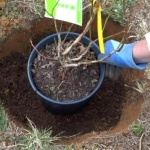
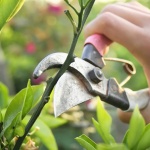
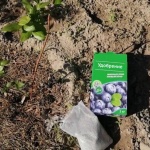
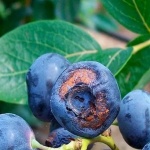
Winter hardiness and the need for shelter
Since the Northblue variety was specially developed for the northern regions of America and Canada, it has excellent frost resistance properties. In this regard, adult healthy plants do not need a winter shelter at all.
It will be necessary to insulate the bushes only at a young age or in those regions where the winter is not very snowy. To do this, cover the aerial part with burlap or spunbond, and the root system will help protect the layer of mulch. This should be done only with the first frosts, and in the spring the shrubs open when a constant comfortable air temperature is established.
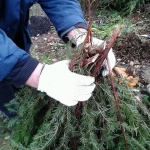
Location and soil requirements
Northblue blueberries are very demanding on the soil on which they will develop. A drained, peat-sandy or peat-loamy substrate is suitable for her, while the acidity level should be quite high.
